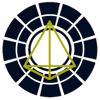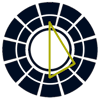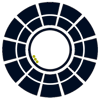The T-Square

The T-Square, similar to the grand cross but with one missing arm, is considered somewhat easier to manage. The absence of one arm provides an escape route and reduces the feeling of being pulled in multiple directions. Tension within the T-Square can be alleviated by planets forming Sextile or Trine aspects to one of its planets. While individuals with a T-Square still face dilemmas related to the cardinal, fixed, and mutable qualities, the planetary energies are less likely to be bottled up, making it easier for them to resolve inner conflicts.
The “T” Square is a tense and dynamic aspect pattern that can be both energizing and inhibiting. In Cardinal Signs, it brings exceptional dynamism and energy. In Fixed Signs, individuals may display excessive stubbornness, fighting personal battles relentlessly. In Mutable Signs, they may attempt to address or even avoid the challenges posed by the “T” Square by being flexible and adaptable.
The Grand Trine

The grand trine is a configuration formed by three or more planets (including sensitive points like the ASC and MC) making trine aspects to each other within one of the elements (Fire, Earth, Air, Water). Traditionally considered highly fortunate, it indicates natural talents that often emerge early in life. However, there may be a tendency to take these gifts for granted, leading to a lack of motivation to develop them further. The influence becomes more positive when one or more planets in the grand trine also form hard aspects, such as squares or oppositions to other planets. This challenges the individual to channel their energies more purposefully. A variation of the grand trine is the minor grand trine, where two planets trine each other and simultaneously form a sextile aspect to another planet. This configuration is similarly beneficial but often more dynamic due to the introduction of perseverance from the sextile aspect.
When the Grand Trine is in Fire Signs, talents are inclined towards enthusiasm and the pursuit of new opportunities. In Earth Signs, talents are more focused on practical endeavors and hands-on experience. Air Signs emphasize intellectual pursuits and the effective communication of ideas. Water Signs indicate talents rooted in empathy, compassion, and intuitive understanding.
The Grand Cross

The grand cross, aptly named, involves planets in both squares and oppositions, encompassing all four signs of a particular quality (cardinal, fixed, or mutable). It’s often dubbed the “Dilemma” because when triggered, typically by a transiting planet, it feels like everything is happening at once. Those with this complex configuration often navigate from one crisis to another, seemingly constantly tested. Yet, once they harness their formidable energies, they can achieve exceptional results. Individuals with a cardinal grand cross possess tremendous drive and energy but encounter significant resistance in realizing their goals. They may attribute their frustrations to external factors, yet much of it is self-induced due to impulsive actions and a lack of careful planning. Fixed grand cross individuals strive to maintain the status quo at all costs, valuing stability and preservation above all else. They vehemently resist anything or anyone disrupting their sense of order, and when change inevitably occurs, it’s often abrupt and dramatic. Mutable grand cross types are more adaptable to change, perhaps too much so. Rather than confront challenges head-on, they tend to change course in hopes of avoiding difficulties. Their conflicts stem from within, arising from inconsistency and spreading themselves too thinly.
When the Grand Cross is in Cardinal Signs, challenges often lead to energetic and assertive behavior as individuals strive to tackle obstacles head-on. In Fixed Signs, people may cling to their problems, exhibiting exceptional stubbornness and resistance to change. For those in Mutable Signs, adaptability is a strength, but there’s a risk of exacerbating problems by avoiding them altogether.
The Grand Quintile, Wreath or Pentagram

The Grand Quintile, a rare aspect pattern, emerges when five planets form Quintiles (72°) with each other. This configuration comprises five Quintiles and five Biquintiles (144° aspects). Its rarity stems from the need for five planets spaced precisely 72° apart. The Sun, Mercury, and Venus typically occupy only one position out of five due to their limited angular separation. While Mercury and Venus can theoretically be up to 74° apart and form a Quintile aspect, such occurrences are exceedingly rare. Achieving a Grand Quintile usually necessitates at least one Quintile between outer planets, occurring during brief and infrequent cycles.
Indeed, the Grand Quintile is intricately tied to harmonics, as it relies on the specific angular relationship of Quintiles between planets. Given that the Quintile is not based on whole-sign aspects, the orb for a Grand Quintile would likely need to be quite narrow, perhaps less than 2° for each aspect, to maintain the precision required for this rare configuration to occur.
Interpreting the Grand Quintile is indeed challenging due to its rarity and the complexity of its harmonic resonance. The 5th harmonic, which is emphasized in this aspect pattern, is associated with creativity, freedom, and change. In numerology, the number 4 symbolizes the material world and structure, while the number 5 represents life energy and creativity. Quintiles are often linked to both immense creative potential and potentially destructive forces. Examples like Charlie Chaplin and Adolf Hitler, who were born close together and had strong 5th harmonic activity in their charts, illustrate the dual nature of Quintiles, showcasing both creative brilliance and destructive tendencies.
Your perspective on the Quintile aspect is insightful. While it may not directly translate into action like some other harmonics, such as the 4th and 8th, it seems to operate more on the mental and intellectual plane, influencing thought processes and creative impulses. In the context of a Grand Quintile, individuals may indeed feel a strong urge to be constantly in motion, immersed in the ever-changing rhythms of life. The aspect’s emphasis on creativity and freedom could drive them to actively engage in the creative process, exploring both the constructive and destructive aspects of creation. The need to participate in the natural cycles of life and to harness the creative spark within them would likely be intense, shaping their approach to various endeavors and experiences.
The Grand Sextile or The Star of David

The Grand Sextile is indeed a fascinating aspect pattern, intricately woven with Sextiles, Trines, and Oppositions, creating a complex interplay of energies. As you mentioned, its occurrence is relatively rare due to the requirement of six planets forming Sextile aspects with each other. This arrangement typically falls within either the Earth and Water elements or the Fire and Air elements, representing the Feminine or Masculine polarities, respectively. In addition to the Sextiles, Trines, and Oppositions, the Grand Sextile also encompasses two Grand Trines, six Kites, and three Mystic Rectangles, further enriching its astrological significance. The presence of these additional configurations adds layers of depth and complexity to the overall energy dynamics of the Grand Sextile, highlighting both harmonious and challenging aspects of life. Overall, the Grand Sextile offers a unique blend of harmonious flow and dynamic tension, inviting individuals to explore the balance between stability and change, creativity and structure, and inner harmony amidst external challenges.
Indeed, the Grand Sextile embodies immense creative potential, representing a harmonious configuration of planetary energies. However, its very nature as a self-contained and balanced pattern also means that it lacks inherent motivation to initiate action or fully realize its creative potential. Unlike other aspect patterns, such as the Grand Trine, which may inspire more direct and focused action, the Grand Sextile requires external stimuli to activate its energies. Due to the involvement of multiple planets and aspects within the Grand Sextile, any external stimulus, whether from transits, progressions, or other astrological factors, may lead to a diffuse and less productive response. The intricate interplay of planetary energies within the Grand Sextile tends to seek a return to equilibrium and balance, often resulting in actions aimed at maintaining or restoring harmony among the six planets involved. While the Grand Sextile offers a fertile ground for creativity and exploration, it may require conscious effort and external triggers to fully activate its potential and translate it into tangible outcomes. Without such stimuli, the energies of the Grand Sextile may remain dormant or expressed in subtle ways, emphasizing the importance of external influences in harnessing its creative power.
Passive transits, occurring within the same polarity as the Grand Sextile, serve to reinforce and emphasize the existing pattern. When a transit passes through a sign aligned with the Grand Sextile’s polarity (such as Earth and Water for a Grand Sextile in Earth and Water signs), it forms conjunctions with one of the planets in the configuration. These conjunctions then trigger trines, oppositions, or sextiles to the other planets involved in the Grand Sextile, enhancing the harmonious flow of energy within the pattern. Conversely, active transits occur within the opposite polarity of the Grand Sextile. For instance, if the Grand Sextile is situated in Earth and Water signs, active transits would involve the Air and Fire signs. These transits bring a contrasting energy that stimulates action and movement within the Grand Sextile configuration. By traversing signs of the opposite polarity, active transits introduce external influences that may challenge the equilibrium of the Grand Sextile, prompting the planets involved to respond and adapt to changing circumstances.
Active transits to Grand Sextiles indeed generate transiting T-Squares and Transiting Yods, with the release point for both patterns occurring at the opposite point from the transiting planet. Typically, such transits would prompt direct and targeted action to address the pressure they create. However, in the context of a Grand Sextile, where there are numerous “soft” aspects to each of the triggered points, much of the discomfort associated with these transits becomes diluted.
The presence of multiple harmonious aspects within the Grand Sextile configuration tends to mitigate the intensity of any challenges posed by the transiting T-Squares and Yods. Consequently, individuals may not feel as compelled to take immediate and decisive action in response to the pressure generated by these transits. Instead, they may experience a more balanced and harmonious approach to addressing any issues that arise, with the inherent stability of the Grand Sextile helping to maintain equilibrium amidst external influences.
Yod (Finger of Fate)

The Yod, also known as the “finger of fate,” is a rare aspect pattern characterized by two planets in sextile to each other, both of which are quincunx (150°) to a third planet. This configuration derives its name from the Hebrew word meaning “blessed,” suggesting a sense of destiny or purpose associated with it. While the Yod presents challenges due to the tension it creates, resolving this tension can lead to significant accomplishments and personal growth.
Working with a Yod is not easy, as it often indicates areas of life where adjustments and realignment are needed. The planets and houses involved in the Yod configuration point to a particular direction or path in life, emphasizing the importance of addressing the issues represented by the involved planets and their corresponding areas of life.
Despite its difficulties, the Yod offers opportunities for profound insight and transformation. By acknowledging and addressing the tensions inherent in this aspect pattern, individuals can tap into their potential for growth and fulfillment, ultimately achieving great success and personal fulfillment.
Boomerang

The Boomerang is a relatively newer aspect pattern, believed to have been named by Marion March. It essentially consists of a Yod configuration with an additional planet positioned at the release point, opposite the apex planet. This additional planet forms two Semi-sextiles with the base planets of the Yod. Similar to how the Opposition in a Grand Trine creates a Kite configuration, the Opposition in the Boomerang serves to introduce a sense of perspective and balance to the aspect pattern. However, in the case of the Boomerang, the Opposition has a more pronounced impact on the overall dynamics of the pattern compared to a Kite configuration.
The additional planet in the Boomerang pattern serves to provide more clarity and direction compared to a traditional Yod. While the Quincunxes still indicate a need for adjustment and a search for balance between two planets, the presence of the Opposition offers a genuine point of equilibrium for the apex planet. This Opposition introduces a sense of balance and perspective that can help individuals navigate the challenges of the aspect pattern more effectively. By staying focused on the opposition, individuals are less likely to encounter issues related to timing and missed opportunities commonly associated with Yod configurations.
Indeed, the two semi-sextiles formed by the Opposition in the Boomerang pattern play a crucial role in integrating the diverse energies of the Quincunxes. By establishing connections between the apex planet and the planets at the base of the Yod, these semi-sextiles contribute to a more harmonious flow of energy within the aspect pattern. Moreover, the presence of the opposing planet brings a heightened awareness of the need for balance and equilibrium in the configuration. This concrete realization of the balance point helps individuals navigate the complexities of the Boomerang pattern with greater clarity and effectiveness.
The Boomerang aspect pattern, with its addition of an Opposition to the apex planet of the Yod, indeed introduces a higher level of complexity and potentiality. This additional dynamic not only enhances the operation of the Yod on the mental/emotional plane but also extends its influence into the physical and material realms, facilitating more tangible and concrete actions.
Moreover, by splitting the isosceles triangle of the Yod into four separate triangles, the Boomerang pattern engages with the realm of “Nous,” as described in Greek philosophy, where individuals encounter their Higher Self and higher guidance. This expansion into the realm of higher consciousness offers an opportunity for deeper integration of conflicting elements and provides support for navigating the lessons presented by the aspect pattern.
In essence, the sacred geometry of the Boomerang offers a framework for transcending limitations and accessing a broader spectrum of experience, enabling individuals to align with their Higher Self and manifest their potential more fully.
The Mystic Rectangle

The Mystic Rectangle is indeed a complex aspect pattern characterized by two oppositions, with the ends forming Sextile or Trine aspects to each other. Its unique shape can sometimes limit the flow of energy to the soft aspects, potentially overlooking the harder ones and leaving significant issues unresolved, akin to the Grand Trine.
However, when the oppositions within the Mystic Rectangle are integrated effectively, the blend of hard and soft aspects can create a dynamic tension that fosters the development of individuals’ natural abilities to their fullest extent. This tension acts as a catalyst for growth and transformation, enabling individuals to navigate challenges and capitalize on opportunities with greater resilience and insight.
The Kite

The Wedge aspect pattern occurs when three planets in a Grand Trine connect to another planet, which opposes one and forms Sextile aspects to the other two. Its impact is similar to that of the Mystic Rectangle in that the abundance of soft aspects may lead to a tendency to avoid confronting the challenges indicated by the planets in hard aspect.
However, if individuals are willing to confront the issues highlighted by the opposition, the potential rewards can be substantial. By addressing and working through the tensions and conflicts represented by the opposition, individuals can unlock greater growth, resilience, and fulfillment in their lives.
The Pointer

The Wedge or Pointer aspect pattern occurs when three planets form a Grand Trine and connect to another planet, which opposes one of them and forms Sextile aspects to the other two. Its impact mirrors that of the Mystic Rectangle, where the abundance of gentle aspects might breed hesitancy in addressing the challenges posed by the planets in more demanding aspects.
However, if individuals are willing to address the issues highlighted by the opposition, the potential rewards can be significant. By facing and working through the tensions and conflicts represented by the opposition, individuals can unlock greater growth, resilience, and fulfillment in their lives.
The Stellium

A stellium, also known as a Satellitium, is an aspect pattern characterized by the clustering of three or more planets within the same sign or house. While the intensity of the effect is heightened when the planets are in the same sign, even when they occupy the same house but in different signs, there is still a noticeable impact. The planets in the stellium form a series of conjunctions, creating a chain-like alignment. While the first and last planets in the chain may not directly aspect each other, their conjunction with the intermediary planets links them together. This configuration amplifies the qualities associated with the sign(s) and house(s) involved, sometimes overwhelmingly so, potentially overshadowing any planets not part of the stellium.
Dissociate Grand Trine

A Dissociate grand trine occurs when one planet of the triangle falls in a different element from the other two. This typically happens when the planets involved are positioned very close to the end or beginning of their respective signs. Because one of the planets in this configuration resides in an element that is not harmonious with the others, the flow of energy is less stable compared to a pure grand trine. The presence of this “errant” planet introduces a sense of tension, akin to a square aspect, into the aspect pattern. As a result, there is a greater potential for utilizing the collective energies of the planets assertively.
Similarly, Dissociate grand crosses and T-Squares are softer versions of their pure forms. In these patterns, at least one planet falls in a different quality compared to the others, thereby reducing the overall level of tension. This principle applies to all dissociate aspect patterns, where the presence of a planet in a different element or quality modifies the dynamic of the configuration.
















































